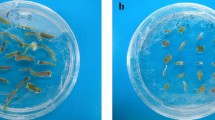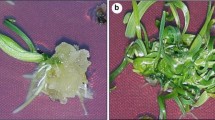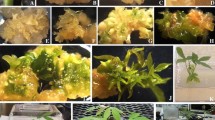Abstract
An effective recovery of plants, genetic engineering, somaclonal variation and haploid induction to improve traits of important crops strongly depend on in vitro systems. For plant molecular breeding and gene transformation, tissue culture is powerful tool. Low efficiency of callus initiation, somatic embryo maturation, and plant regeneration is a major problem in rye tissue culture; therefore, rye is recognized as one of the most recalcitrant species for this process. The aim of this study was to develop optimum, stable and reproducible callus formation and regeneration system for rye to overcome this restriction. To establish an efficient protocol, the effects of three types of explants (intact mature embryo, scratched mature embryo and endosperm-supported mature embryo), carbohydrate source (20 g/L of sucrose and 40 g/L of maltose), auxin type [2,4-dichlorophenoxyacetic acid (2, 4-D), 3,6-dichloro-2-methoxybenzoic acid (dicamba) and 4-Amino-3,5,6-trichloro-2-pyridinecarboxylic acid (picloram)], and auxin concentration (2, 4, 6, 8, 10 and 12 mg/L) on callus formation rate (%), embryogenic callus formation rate (%), responded embryogenic callus rate (%), and regeneration efficiency of rye (Secale cereale L.) were evaluated. The best explant type for plant regeneration was found to be endosperm-supported mature embryo. Our results revealed that the highest responded embryogenic callus rate (60%) and regeneration efficiency (n = 1.24) were obtained from the MS medium containing maltose and 12 mg/L picloram in endosperm-supported mature embryo. This protocol provides a basis for future studies on genetic transformation of rye.


Similar content being viewed by others
Abbreviations
- CF:
-
Callus formation
- Dicamba :
-
3,6-dichloro-2-methoxybenzoic acid
- ECF :
-
Embryogenic callus formation
- EME :
-
Endosperm-supported mature embryo
- IME :
-
Intact mature embryo
- MES hydrate :
-
2-(N-Morpholino)ethanesulfonic acid hydrate
- MS:
-
Murashige and Skoog 1962
- Picloram :
-
4-Amino-3,5,6-trichloro-2-pyridinecarboxylic acid
- RE :
-
Regeneration efficiency
- REC :
-
Responded embryogenic callus
- SME :
-
Scratched mature embryo
- TDZ :
-
Thidiazuron
- 2,4-D :
-
2,4-dichlorophenoxyacetic acid
References
Altpeter F, Juan CP, Wieser H (2004) Stable expression of 1Dx5 and 1Dy10 high-molecular-weight glutenin subunit genes in transgenic rye drastically increases the polymeric glutelin fraction in rye flour. Plant Mol Biol 54:783–792. https://doi.org/10.1007/s11103-004-0122-5
Aydin M, Tosun M, Haliloglu K (2011) Plant regeneration in wheat mature embryo culture. Afr J Biotechnol 10:15749–15755 http://www.academicjournals.org/AJB
Aydin M, Arslan E, Taspinar MS, Karadayi G, Agar G (2016a) Analyses of somaclonal variation in endosperm-supported mature embryo culture of rye (Secale cereale L). Biotechnol Biotechnol Equip 30:1082–1089. https://doi.org/10.1080/13102818.2016.1224980
Aydin M, Hossein-Pour A, Halİloğlu K, Tosun M (2016b) Effect of polyamines on somatic embryogenesis via mature embryo in wheat. Turk J Biol 40:1178–1184. https://doi.org/10.3906/biy-1601-21
Barro F, Cannell M, Lazzeri P, Barcelo P (1998) The influence of auxins on transformation of wheat and tritordeum and analysis of transgene integration patterns in transformants. Theor Appl Genet 97:684–695. https://doi.org/10.1007/s001220050944
Barro F, Martin A, Lazzeri PA, Barceló P (1999) Medium optimization for efficient somatic embryogenesis and plant regeneration from immature inflorescences and immature scutella of elite cultivars of wheat, barley and tritordeum. Euphytica 108:161–167. https://doi.org/10.1023/A:1003676830857
Bartók T, Sági F (1990) A new, endosperm-supported callus induction method for wheat (Triticum aestivum L.) plant cell. Tissue Organ Cult 22:37–41. https://doi.org/10.1007/BF00043696
Bi R, Kou M, Chen L, Mao S, Wang H (2007) Plant regeneration through callus initiation from mature embryo of Triticum. Plant Breed 126:9–12. https://doi.org/10.1111/j.1439-0523.2007.01327.x
Birsin MA, Ozgen M (2004) A comparison of callus induction and plant regeneration from different embryo explants of triticale (X Triticosecale Wittmack). Cell Mol Biol Lett 9:353–362 https://www.cmbl.org.pl
Birsin MA, Özgen M (2008) Callus Formation and Plant Regeneration from Cultured Embryos of Diploid and Tetraploid Winter Ryes (Secale cereale L.). J Plant Biochem Biotechnol 17:81–84. https://doi.org/10.1007/BF03263265
Blanc G, Lardet L, Martin A, Jacob J-L, Carron M-P (2002) Differential carbohydrate metabolism conducts morphogenesis in embryogenic callus of Hevea brasiliensis (Mull. Arg.). J Exp Bot 53:1453–1462. https://doi.org/10.1093/jexbot/53.373.1453
Carman J (1988) Improved somatic embryogenesis in wheat by partial simulation of the in-ovulo oxygen, growth-regulator and desiccation environments. Planta 175:417–424. https://doi.org/10.1007/BF00396349
Castillo AM, Vasil V, Vasil IK (1994) Rapid production of fertile transgenic plants of rye (Secale cereale L.). Nat Biotechnol 12:1366. https://doi.org/10.1038/nbt1294-1366
Chauhan H, Desai SA, Khurana P (2007) Comparative analysis of the differential regeneration response of various genotypes of Triticum aestivum, Triticum durum and Triticum dicoccum. Plant Cell Tissue Organ Cult 91:191–199. https://doi.org/10.1007/s11240-007-9285-5
Chen J-Y, Yue R-Q, Xu H-X, Chen X-J (2006) Study on plant regeneration of wheat mature embryos under endosperm-supported culture. Agric Sci China 5:572–578. https://doi.org/10.1016/S1671-2927(06)60094-1
Chu C, Hill R, Brule-Babel L (1990) High frequency of pollen embryoid formation and plant regeneration in Triticum aestivum L. on monosaccharide containing media. Plant Sci 66:255–262. https://doi.org/10.1016/0168-9452(90)90211-6
D’Onofrio C, Morini S (2005) Development of adventitious shoots from in vitro grown Cydonia oblonga leaves as influenced by different cytokinins and treatment duration. Biol Plant 49:17–21. https://doi.org/10.1007/s10535-005-7021-8
Dahleen LS (1999) Donor-plant environment effects on regeneration from barley embryo-derived callus. Crop Sci 39:682–685. https://doi.org/10.2135/cropsci1999.0011183X003900020013x
Daniel G (1993) Anther culture in Rye: improved plant regeneration using modified MS-media. Plant Breed 110:259–261. https://doi.org/10.1111/j.1439-0523.1993.tb00587.x
de Moura, L. C., Xavier, A., da Cruz, A. C. F., Gallo, R., Gatti, K. C., Miranda, N. A., & Otoni, W. C. (2017). Effects of explant type, culture media and picloram and dicamba growth regulators on induction and proliferation of somatic embryos in eucalyptus grandis X E. urophylla. Revista Árvore 41(5):1–10.
Eapen S, Rao P (1985) Plant regeneration from immature inflorescence callus cultures of wheat, rye and triticale. Euphytica 34:153–159. https://doi.org/10.1007/BF00022875
Faria, R. T. D., Rodrigues, F. N., Oliveira, L. D. V., & Müller, C. (2004). In vitro Dendrobium nobile plant growth and rooting in different sucrose concentrations. Horticultura Brasileira 22(4):780–783.
Fehér A (2015) Somatic embryogenesis stress-induced remodeling of plant cell fate. Biochim et Biophysica Acta (BBA)-Gene Regul Mechan 1849:385–402. https://doi.org/10.1016/j.bbagrm.2014.07.005
Filippov M, Miroshnichenko D, Vernikovskaya D, Dolgov S (2006) The effect of auxins, time exposure to auxin and genotypes on somatic embryogenesis from mature embryos of wheat. Plant Cell Tissue Organ Cult 84:213–222. https://doi.org/10.1007/s11240-005-9026-6
Fitch MM, Moore PH (1990) Comparison of 2, 4-D and picloram for selection of long-term totipotent green callus cultures of sugarcane. Plant Cell Tissue Organ Cult 20:157–163. https://doi.org/10.1007/BF00041876
Flehinghaus T, Deimling S, Geiger HH (1991) Methodical improvements in rye anther culture. Plant Cell Rep 10:397–400. https://doi.org/10.1007/BF00232610
Gadaleta A, Giancaspro A, Blechl A, Blanco A (2006) Phosphomannose isomerase, pmi, as a selectable marker gene for durum wheat transformation. J Cereal Sci 43:31–37. https://doi.org/10.1016/j.jcs.2005.06.004
Geiger H, Schnell F (1970) Cytoplasmic male sterility in Rye (Secale cereale L.) 1. Crop Sci 10:590–593. https://doi.org/10.2135/cropsci1970.0011183X001000050043x
Gerdakaneh M, Zohori M (2013) The Effect of Picloram on Somatic Embryogenesis of Different Explants of Strawberry (Fragaria ananassa Duch). Biology 3:133–142. https://doi.org/10.9734/BBJ/2013/2370
Groll J, Mycock D, Gray V, Laminski S (2001) Secondary somatic embryogenesis of cassava on picloram supplemented media. Plant Cell Tissue Organ Cult 65:201–210. https://doi.org/10.1023/A:1010622424627
Gurel S, Gurel E, Kaur R, Wong J, Meng L, Tan H-Q, Lemaux PG (2009) Efficient, reproducible agrobacterium-mediated transformation of sorghum using heat treatment of immature embryos. Plant Cell Rep 28:429–444. https://doi.org/10.1007/s00299-008-0655-1
Hakam N, Udupa SM, Gaboun F, Rabha A, Ibriz M, Iraqi D (2014) Effect of genotypes and culture media on embryogenic callus induction and plantlet regeneration from mature embryos of durum wheat. Rom Agric Res 31:121–128
Haliloglu K, Aydin M (2016) Efficient regeneration system from rye leaf base segments. SpringerPlus 5:2005. https://doi.org/10.1186/s40064-016-3689-9
He T, Jia J (2008) High frequency plant regeneration from mature embryo explants of highland barley (Hordeum vulgare L. var. nudum Hk. f.) under endosperm-supported culture. Plant Cell Tissue Organ Cult 95:251–254. https://doi.org/10.1007/s11240-008-9437-2
He G, Lazzeri P (2001) Improvement of somatic embryogenesis and plant regeneration from durum wheat (Triticum turgidum var. durum Desf.) scutellum and inflorescence cultures. Euphytica 119:369–376. https://doi.org/10.1023/A:1017587628995
Jelaska S, Rengel Z, Cesar V (1984) Plant regeneration from mesocotyl callus of Hordeum vulgare L. Plant Cell Rep 3:125–129. https://doi.org/10.1007/BF00270204
Karami O, Deljou A, Pour AM (2007) Repetitive somatic embryogenesis in carnation on picloram supplemented media. Plant growth regulation 51:33–39. https://doi.org/10.1007/s10725-006-9144-0
Kishore GM, Shewmaker C (1999) Biotechnology: Enhancing human nutrition in developing and developed worlds. Proc Natl Acad Sci 96:5968–5972. https://doi.org/10.1073/pnas.96.11.5968
Kohli A, Twyman RM, Abranches R, Wegel E, Stoger E, Christou P (2003) Transgene integration, organization and interaction in plants. Plant Mol Biol 52:247–258. https://doi.org/10.1023/A:1023941407376
Krumbiegel-Schroeren G, Finger J, Schroeren V, Binding H (1984) Embryoid formation and plant regeneration from callus of Secale cereale L. Zeitschrift fur Pflanzenzuchtung= Journal of Plant Breeding 92: 89–94
Kuhlmann U, Foroughi-Wehr B (1989) Production of doubled haploid lines in frequencies sufficient for barley breeding programs. Plant Cell Rep 8:78–81. https://doi.org/10.1007/BF00716843
Last DI, Brettell RI (1990) Embryo yield in wheat anther culture is influenced by the choice of sugar in the culture medium. Plant Cell Rep 9:14–16. https://doi.org/10.1007/BF00232126
Lemos E, Baker D (1998) Shoot regeneration in response to carbon source on internodal explants of Annona muricata L. Plant Growth Regul 25:105–112. https://doi.org/10.1023/A:1006058301707
Lezin F, Sarrafi A, Alibert G (1996) The effects of genotype, ploidy level and cold pretreatment on barley anther culture responsiveness. Cereal Research Communications:7–13
Linacero R, Vazquez A (1986) Somatic embryogenesis and plant regeneration from leaf tissues of rye (Secale cereale L). Plant Sci 44:219–222. https://doi.org/10.1016/0168-9452(86)90094-4
Lu C-Y, Chandler SF, Vasil IK (1984) Somatic embryogenesis and plant regeneration from cultured immature embryos of rye (Secale cereale L). J Plant Physiol 115:237–244. https://doi.org/10.1016/S0176-1617(84)80126-1
McHughen A (1983) Rapid regeneration of wheat in vitro. Ann Bot 51:851–853. https://doi.org/10.1093/oxfordjournals.aob.a086535
Mendoza MG, Kaeppler HF (2002) Auxin and sugar effects on callus induction and plant regeneration frequencies from mature embryos of wheat (Triticum aestivum L). In Vitro Cell Dev Biol-Plant 38:39–45. https://doi.org/10.1079/IVP2001250
Miedaner T (1997) Breeding wheat and rye for resistance to Fusarium diseases. Plant Breed 116:201–220. https://doi.org/10.1111/j.1439-0523.1997.tb00985.x
Motallebi-Azar A, Kazemiani S (2011) Effects of carbon source and hydrolyzed casein on callus and shoot induction in Hypericum Perforatum cv. Helos. International Journal of Medicinal and Aromatic Plants 1:313–318
Murashige T, Skoog F (1962) A revised medium for rapid growth and bio assays with tobacco tissue cultures. Physiol Plant 15:473–497. https://doi.org/10.1111/j.1399-3054.1962.tb08052.x
Orshinsky BR, McGregor LJ, Johnson GI, Hucl P, Kartha KK (1990) Improved embryoid induction and green shoot regeneration from wheat anthers cultured in medium with maltose. Plant Cell Rep 9:365–369. https://doi.org/10.1007/BF00232400
Özgen M, Türet M, Özcan S, Sancak C (1996) Callus induction and plant regeneration from immature and mature embryos of winter durum wheat genotypes. Plant Breed 115:455–458. https://doi.org/10.1111/j.1439-0523.1996.tb00956.x
Ozias-Akins P, Vasil IK (1982) Plant regeneration from cultured immature embryos and inflorescences of Triticum aestivum L.(wheat): evidence for somatic embryogenesis. Protoplasma 110:95–105. https://doi.org/10.1007/BF01281535
Perrin M, Gertz C, Masson JE (2004) High efficiency initiation of regenerable embryogenic callus from anther filaments of 19-grapevine genotypes grown worldwide. Plant Sci 167:1343–1349. https://doi.org/10.1016/j.plantsci.2004.07.009
Popelka J, Altpeter F (2001) Interactions between genotypes and culture media components for improved in vitro response of rye (Secale cereale L.) inbred lines plant cell reports 20:575-582. https://doi.org/10.1007/s002990100369
Popelka JC, Altpeter F (2003) Agrobacterium tumefaciens-mediated genetic transformation of rye (Secale cereale L). Mol Breed 11:203–211. https://doi.org/10.1023/A:1022876318276
Popelka JC, Xu J, Altpeter F (2003) Generation of rye (Secale cereale L.) plants with low transgene copy number after biolistic gene transfer and production of instantly marker-free transgenic rye. Transgenic Res 12:587–596. https://doi.org/10.1023/A:1025822731661
Pritchard J, Jones RW, Tomos A (1991) Turgor, growth and rheological gradients of wheat roots following osmotic stress. J Exp Bot 42:1043–1049. https://doi.org/10.1093/jxb/42.8.1043
Rakoczy-Trojanowska M, Malepszy S (1993) Genetic factors influencing regeneration ability in rye (Secale cereale L.). I. Immature inflorescences. Theor Appl Genet 86:406–410. https://doi.org/10.1007/BF00838554
Reinhardt D (2003) Vascular patterning: more than just auxin? Curr Biol 13:R485–R487. https://doi.org/10.1016/S0960-9822(03)00409-3
Rolland F, Moore B, Sheen J (2002) Sugar sensing and signaling in plants. Plant Cell 14:S185–S205. https://doi.org/10.1105/tpc.010455
Sahrawat AK, Chand S (2004) High frequency plant regeneration from coleoptile tissue of barley (Hordeum vulgare L). Plant Sci 167:27–34. https://doi.org/10.1016/j.plantsci.2004.02.019
Sairam R, Prakash C (2005) Obpc symposium: maize 2004 & beyond–can agricultural biotechnology contribute to global food security? In Vitro Cell Dev Biol-Plant 41:424–430. https://doi.org/10.1079/IVP2005663
Sarker R, Biswas A (2002) In vitro plantlet regeneration and Agrobacterium-mediated genetic transformation of wheat (Triticum aestivum L). Plant Tissue Cult 12:155–165
Shrawat AK, Lörz H (2006) Agrobacterium-mediated transformation of cereals: a promising approach crossing barriers. Plant Biotechnol J 4:575–603. https://doi.org/10.1111/j.1467-7652.2006.00209.x
Smith FW, Ealing PM, Hawkesford MJ, Clarkson DT (1995) Plant members of a family of sulfate transporters reveal functional subtypes. Proc Natl Acad Sci 92:9373–9377. https://doi.org/10.1073/pnas.92.20.9373
Souter M, Lindsey K (2000) Polarity and signalling in plant embryogenesis. J Exp Bot 51:971–983. https://doi.org/10.1093/jexbot/51.347.971
Steinau M, McCoy SB, Trick HN (2002) Recent advances in wheat transformation. In Vitro Cell Dev Biol-Plant 38:404–414. https://doi.org/10.1079/IVP2002320
Steinmacher D, Guerra M, Saare-Surminski K, Lieberei R (2011) A temporary immersion system improves in vitro regeneration of peach palm through secondary somatic embryogenesis. Ann Bot 108:1463–1475. https://doi.org/10.1093/aob/mcr033
Strickland SG, Nichol JW, McCall CM, Stuart DA (1987) Effect of carbohydrate source on alfalfa somatic embryogenesis. Plant Sci 48:113–121. https://doi.org/10.1016/0168-9452(87)90138-5
Tang G, Zhou W, Li H, Mao B, He Z, Yoneyama K (2003) Medium, explant and genotype factors influencing shoot regeneration in oilseed Brassica spp. J Agron Crop Sci 189:351–358. https://doi.org/10.1046/j.1439-037X.2003.00060.x
Thompson MR, Thorpe TA (1987) Metabolic and non-metabolic roles of carbohydrates. Cell and tissue culture in forestry. Springer, pp 89–112. https://doi.org/10.1007/978-94-017-0994-1_6
Vyroubalová Š, Šmehilová M, Galuszka P, Ohnoutková L (2011) Genetic transformation of barley: limiting factors. Biol Plant 55:213–224. https://doi.org/10.1007/s10535-011-0032-8
Wang C-T, Wei Z-M (2004) Embryogenesis and regeneration of green plantlets from wheat (Triticum aestivum L.) leaf base. Plant Cell Tissue Organ Cult 77:149–156. https://doi.org/10.1023/B:TICU.0000016818.58971.cc
Whitney PJ (1996) Hormone independent root organ cultures of rye (Secale cereale L.). Plant Cell Tissue Organ Cult 46:109–115. https://doi.org/10.1007/BF00034843
Zhou H, Zheng Y, Konzak C (1991) Osmotic potential of media affecting green plant percentage in wheat anther culture. Plant Cell Reports 10:63–66. https://doi.org/10.1007/BF00236458
Zimmerman TW, Cobb BG (1989) Vitrification and soluble carbohydrate levels inPetunia leaves as influenced by media gelrite and sucrose concentrations. Plant Cell Rep 8:358–360. https://doi.org/10.1007/BF00716673
Zimny J, Lorz H (1989) High frequency of somatic embryogenesis and plant regeneration of rye (Secale cereale L). Plant Breed 102:89–100. https://doi.org/10.1111/j.1439-0523.1989.tb00320.x
Acknowledgments
We thank Ataturk University for support for this project. The project was partially supported by the Ataturk University (Grant No. BAP 2011/167).
Author information
Authors and Affiliations
Corresponding author
Ethics declarations
Conflict of interest
We declare that we have no conflict of interest.
Additional information
Publisher’s note
Springer Nature remains neutral with regard to jurisdictional claims in published maps and institutional affiliations.
Rights and permissions
About this article
Cite this article
Hossein Pour, A., Aydin, M. & Haliloglu, K. Plant regeneration system in recalcitrant rye (Secale cereale L.). Biologia 75, 1017–1028 (2020). https://doi.org/10.2478/s11756-019-00395-9
Received:
Accepted:
Published:
Issue Date:
DOI: https://doi.org/10.2478/s11756-019-00395-9




